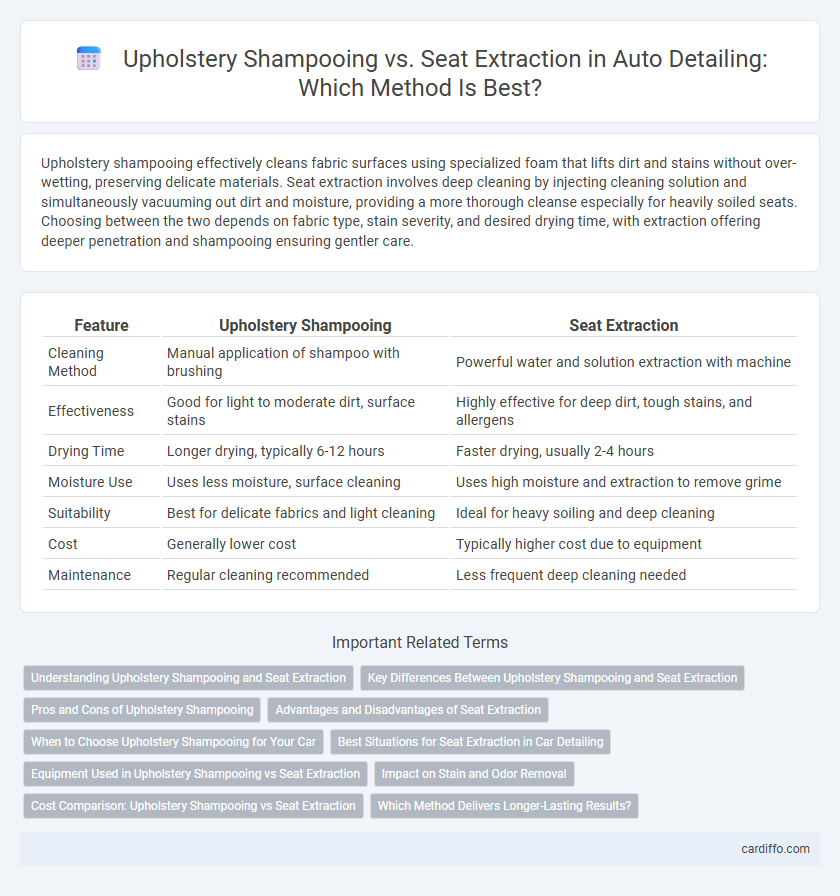Upholstery shampooing effectively cleans fabric surfaces using specialized foam that lifts dirt and stains without over-wetting, preserving delicate materials. Seat extraction involves deep cleaning by injecting cleaning solution and simultaneously vacuuming out dirt and moisture, providing a more thorough cleanse especially for heavily soiled seats. Choosing between the two depends on fabric type, stain severity, and desired drying time, with extraction offering deeper penetration and shampooing ensuring gentler care.
Table of Comparison
| Feature | Upholstery Shampooing | Seat Extraction |
|---|---|---|
| Cleaning Method | Manual application of shampoo with brushing | Powerful water and solution extraction with machine |
| Effectiveness | Good for light to moderate dirt, surface stains | Highly effective for deep dirt, tough stains, and allergens |
| Drying Time | Longer drying, typically 6-12 hours | Faster drying, usually 2-4 hours |
| Moisture Use | Uses less moisture, surface cleaning | Uses high moisture and extraction to remove grime |
| Suitability | Best for delicate fabrics and light cleaning | Ideal for heavy soiling and deep cleaning |
| Cost | Generally lower cost | Typically higher cost due to equipment |
| Maintenance | Regular cleaning recommended | Less frequent deep cleaning needed |
Understanding Upholstery Shampooing and Seat Extraction
Upholstery shampooing involves applying a specialized cleaning solution to fabric surfaces, loosening dirt and stains before being wiped or vacuumed away, making it ideal for removing surface grime in car interiors or furniture. Seat extraction uses powerful steam or hot water extraction equipment to deeply penetrate fabric and foam layers, extracting embedded dirt, allergens, and moisture for a thorough clean and faster drying time. Both methods target fabric upholstery cleaning but differ in technique and depth, with seat extraction providing a more intensive, deep-cleaning approach.
Key Differences Between Upholstery Shampooing and Seat Extraction
Upholstery shampooing involves applying a foamy detergent to fabric surfaces followed by brushing to lift dirt and stains, making it ideal for delicate materials. Seat extraction uses a powerful vacuum and water solution to deeply penetrate and remove embedded debris and grime, offering a more thorough cleaning for heavily soiled seats. The primary difference lies in shampooing's surface-level cleaning versus extraction's deep-cleaning extraction method.
Pros and Cons of Upholstery Shampooing
Upholstery shampooing effectively removes surface-level dirt and stains from fabric seats, offering a deep clean that revitalizes the appearance of vehicle interiors. However, this method may leave excess moisture that prolongs drying time and can potentially lead to mold or mildew if not properly ventilated. Compared to seat extraction, upholstery shampooing is generally more affordable but less thorough in removing embedded grime and allergens.
Advantages and Disadvantages of Seat Extraction
Seat extraction offers deep cleaning by removing embedded dirt, allergens, and stains from upholstery fibers, providing a more thorough cleanse compared to surface-level shampooing. However, this method requires specialized equipment and skilled operators, making it more costly and time-consuming, with potential risks of over-wetting leading to mold or fabric damage. Despite these drawbacks, seat extraction is ideal for heavily soiled or neglected upholstery, delivering superior restoration and longevity.
When to Choose Upholstery Shampooing for Your Car
Upholstery shampooing is ideal for routine maintenance or when fabric seats have surface dirt and mild stains, ensuring a thorough clean without soaking the cushions. Choose this method if your car's upholstery is only lightly soiled and you want to refresh the interior without the risk of over-wetting. This technique effectively removes surface grime, allergens, and odors while preserving fabric integrity and preventing excessive drying time.
Best Situations for Seat Extraction in Car Detailing
Seat extraction is ideal for heavily soiled or stained car upholstery, effectively removing deep-seated dirt, allergens, and spills. This method uses powerful extraction machines to inject and remove cleaning solutions, ensuring thorough cleaning and faster drying times. Seat extraction is best suited for fabric seats with persistent grime where shampooing alone cannot achieve optimal cleanliness.
Equipment Used in Upholstery Shampooing vs Seat Extraction
Upholstery shampooing utilizes rotary brushes and foam applicators to scrub fabric surfaces gently, ensuring deep cleaning without excessive moisture. Seat extraction relies on high-powered extraction machines with strong suction and hot water injection to remove embedded dirt and allergens effectively. Both methods require specialized equipment, but extraction machines offer superior dirt removal through simultaneous washing and vacuuming processes.
Impact on Stain and Odor Removal
Upholstery shampooing uses a foam-based cleaner that penetrates fabric fibers to lift surface stains and reduce mild odors, making it suitable for regular maintenance. Seat extraction employs high-pressure hot water combined with powerful suction to deeply remove embedded dirt, stubborn stains, and persistent odors from upholstery. This method offers a more thorough clean, effectively restoring the fabric's appearance and freshness by targeting contaminants beneath the surface.
Cost Comparison: Upholstery Shampooing vs Seat Extraction
Upholstery shampooing typically costs between $50 and $150 per vehicle, whereas seat extraction ranges from $75 to $200 depending on the vehicle size and fabric condition. Seat extraction often involves deeper cleaning methods using specialized machines that justify its higher price, delivering more thorough removal of dirt and allergens. Choosing between these services depends on budget constraints and the desired level of cleaning effectiveness for automotive interiors.
Which Method Delivers Longer-Lasting Results?
Upholstery shampooing penetrates fabric fibers to break down dirt and stains, but may leave moisture that causes quicker re-soiling. Seat extraction uses powerful suction to remove deep-seated debris and moisture, promoting faster drying and more durable cleanliness. Seat extraction typically delivers longer-lasting results due to thorough dirt removal and improved fabric preservation.
Upholstery Shampooing vs Seat Extraction Infographic

 cardiffo.com
cardiffo.com